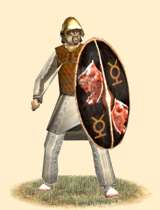Parthohellenikoi Thureophoroi (Parthian Hellenic Infantry)
 |
Weapons | Defence | Mental | ||||||
|---|---|---|---|---|---|---|---|---|---|
| Primary | Secondary | Armour: | 7 | Morale: | 11 | ||||
| Type: | spear | sword | Shield: | 3 | Discipline: | normal | |||
| Attack: | 6 | 10 | Skill: | 9 | Training: | trained | |||
| Charge: | 4 | 4 | Recruitment | Other | |||||
| Lethality: | 1 | 0.13 | Soldiers: | 40 | Hit Points: | 1 | |||
| Range: | 35 | 0 | Cost: | 1208 | Mass: | 1.13 | |||
| Ammo: | 2 | 0 | Upkeep: | 302 | |||||
| Turns: | 1 | ||||||||

These Parthian medium infantry, drafted from foreigners and natives of the Near East, are best used as the infantry core of a garrison army where their versatility against most infantry and cavalry may be put to use.
Hardy
These Thureophoroi are little different from their brethren of Hellene nations, and while not particularly compatible with the fleet nature of the horsemen of the Pahlavân, rendered good use as garrison soldiers of the numerous Parthian cities in western Iran and Mesopotamia, descended from Greeks, even deported or captured Romans and possibly the local Chaldaeans. In the event of siege, their defensive value against both infantry and cavalry, their versatility makes them some of the most reliable infantry available to the Parthians.
Armed with a thrusting spear, along with the large and robust thureos shield, they have their qualities as a defensive force keeping both a strong front against infantry and as a reliable counter against most cavalry units, along with the javelins, softening up the enemy’s lines. Their relatively light armour, of quilted leather or linen along with their helmets indicate that these infantry are of the medium class; Able to skirmish but at the same able to fight as heavy infantry. Duly noted is that while they are quite reliable, Parthian commanders were trained to command cavalry, and with Hellenes and Romans having a more deeply rooted martial tradition for infantry, the Parthohellenikoi should not be considered a decisive element in Parthian warfare.In the wake of Parthian conquests and Seleukid decline, an already established Hellenic infantry tradition could not find itself compatible with the equestrian armies of the conquerors. Especially in the western regions of Iran proper, Mesopotamia, Syria and the Levant, the tradition could not be entirely discarded in favour of the classical Parthian military organization. It was not uncommon that non-equestrian troops or mercenaries were used by the Parthians in special circumstances, which would entail light infantry, foot archers, phalangites or sometimes even rebel legionnaires, but in most cases they were confined to garrison duties. Due to a large numbers of Greeks and Non-Iranians in the western reaches of the Parthian empire, there would also have been a local garrison reflecting the local martial traditions. Later Sassanian combat infantry may actually be derived, not only from the classical Achaemenid traditions, but also from a strong foundation of combat infantry from Greek and Roman influences.